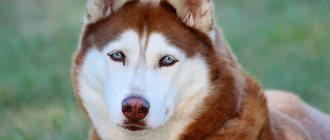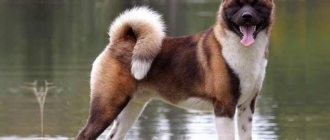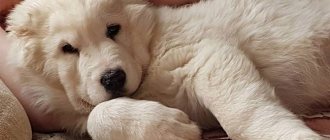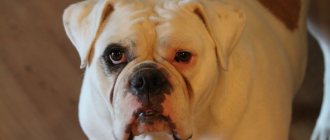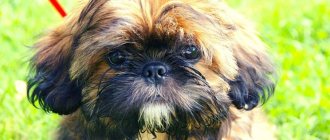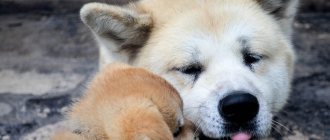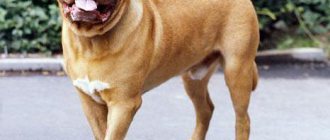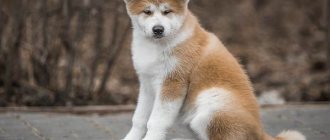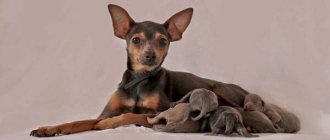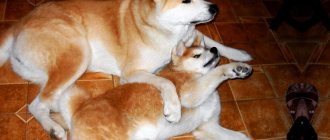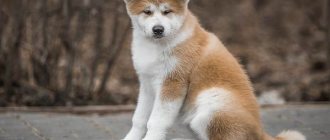| Type |
|
| Size | medium (11-25kg) |
| Main features |
|
| Included in |
|
| Intelligence | 85% |
Ainu, also known as Hokkaido, is the oldest Japanese dog breed with a very interesting appearance and unique character. They are distinguished by fearlessness and intelligence, but sometimes they show an obstinate disposition. More than a thousand years ago, domesticated dogs began to hunt and even fish with humans. Now this is a devoted companion dog that many lovers dream of. But not everyone can afford to have an Ainu.
In Japan, Hokkaido dogs are considered specially protected animals. They are prohibited from being exported from the islands. Therefore, for other countries, the Ainu-ken is exotic, and the kennels where these dogs are found can be counted on one hand.
Why Hokkaido dogs have become rare and is it worth getting them? The answers to these and other questions are below.
History of the American Akita
American Akita
The word "American" in the breed's name can be confusing when it comes to its origins. The second name - large Japanese dog - is more eloquent in this regard: its homeland is the Land of the Rising Sun. But how did it happen that the Akita suddenly became American?
The ancestors of the American Akita are the Japanese Akita Inu, which were originally used for hunting and guard purposes. Several centuries ago they were called differently: Matagi-Akita. Later they began to be used in dog fighting, which became especially popular at the turn of the 19th and 20th centuries. In pursuit of monetary gain, owners sought to “improve” their dogs, making them larger and stronger. For this purpose, they were crossed with breeds brought to the islands such as mastiffs and shepherd dogs.
However, as a result of these manipulations, the classic features of the breed began to blur, deteriorate, or even be completely lost. The damage caused to the Matagi Akita was noticed at a dog show held in Tokyo in 1914. Soon, pure representatives of the breed were declared natural monuments, and their crossing with representatives of other species was strictly prohibited. The breeders had more work to do: they did everything possible to return the Matagi Akita to its original characteristics.
Before these magnificent dogs, which became the source of national pride for the Japanese, had time to recover from the blow inflicted on the breed by irrepressible human greed, World War II broke out. By order of the government, all breeders donated their pets to the needs of the front. As is known, the end of the war was marked by the surrender of Japan in 1945. Returning to their homeland, US military personnel decided to take with them several puppies they liked. It was they who became, a few years later, the progenitors of a new breed. But the actual classic Akita Inu remained on the Japanese Islands after the war, no more than 20 individuals.
Japanese Akita Inu
At the same time, overseas the breed began to gain widespread recognition and developed at a rapid pace. At first it was called a large Japanese dog. But in the States, work on the breed was not synchronized with the Japanese - it proceeded in parallel and, as they say, on its own path. Japanese breeders tried to negotiate with their American colleagues regarding her common pedigree, but in vain. They did not even allow dogs declared natural monuments on the islands to be exported to the United States. All these measures did not stop the Americans. As a result, over time, the overseas Akita began to differ from the Japanese one in both appearance and character. And then it received a new name - American Akita.
In 1956, a club for the newly formed breed was created, recognized by the American Kennel Club only in 1972. The “breed war” with Japan continued until 1992: for two decades, the kennel clubs of both countries did not recognize each other - only the Japanese Akita Inu was registered with the Fédération Cynologique Internationale (FCI). The official division of the breeds occurred only in 2000, when the FCI approved the standard for the overseas Akita.
What is the difference from the standard?
External differences
- Height and weight . The Shiba Inu is approximately half the length and three times lighter than the larger Akita Inu.
- Color . Black and tan coloring is typical only for Shibas, but, on the other hand, only standard Akita Inus are brindle.
- Body type . Shibas look somewhat shorter-legged than Akitas. At the same time, due to their lighter frame, they do not seem massive.
- The structure of the head and muzzle . If the head of a standard Akita is somewhat similar to a bear's, then the outlines of the Shiba's muzzle clearly show fox-like features.
Temperament and character
Despite the fact that here too these breeds have a lot in common, for example, a calm and balanced disposition, intelligence and nobility, it should be noted that the Shiba Inu is somewhat more playful and active than the Akita. These dogs are characterized by a kind of humor: they love to make faces, which cannot be said about the Akita - they are more restrained and majestic.
The main difference in the character of these dogs is that the Shiba Inu has more hunting qualities than watchdogs, however, this does not make it a worse guard than its larger “relative”.
Features of the American Akita
The American Akita is an excellent hunter. If you suppress this natural quality in a dog, it will still manifest itself in one way or another, and not in the most pleasant way for the owner. For example, on a walk your pet will begin to rush at smaller dogs or “bully” the cat living in the same house.
The American Akita is also called a one-owner dog. She has a very hard time with a change of owner and often cannot adapt to living in another place for the rest of her life. A classic example is the famous Hachiko, an Akita Inu dog, who gained fame throughout Japan in 1932 after the publication in one of the largest Tokyo newspapers of the article “A devoted old dog awaits the return of his owner, who died seven years ago.” Based on this story, which touched the hearts of millions of people around the world, a film was made in 2009 with Richard Gere in the title role.
As you can see, the American Akita inherited this quality from its Japanese counterparts - devotion. It will be especially difficult to find common ground with an adult dog for those new owners who have not previously had experience communicating with large Molossians.
Brief history of origin
The Akita dog breed is one of the oldest known to man. Mentions of it and drawings date back to the second century BC. In Japan, the breed was declared a national treasure. Clubs have been organized whose activities are aimed at preserving these ancient dogs. They developed rules for keeping Akita Inu, instructions for training and breeding, and prescribed standard parameters. Officially, this breed began to be mentioned in Japan in 1928, and received international recognition in 1964.
Heritage of Japan - Akita
Appearance of the breed
American Akita puppy
The American Akita is a very large dog. Strength and power can be read in her every movement. Gradually, the hunting skills of these dogs are becoming a thing of the past, which is largely due to their large size, which prevents the overseas “Japanese” from remaining fast and agile hunters.
Thanks to its special appearance features, namely its spectacular color and perfect lines, the American Akita has long been “registered” at dog shows in different countries of the world, including Russia. Representatives of the breed often lead in BESTS of the fifth group, often winning entire competitions.
general description
It is very difficult to confuse an American Akita with another breed - it is almost impossible, even if before “personal acquaintance” you had only seen it in a photo. The first thing that will catch your eye, in addition to its impressive size, is its strong body with well-developed muscles and massive bones. The “bear” type muzzle with small eyes and a relatively short bridge of the nose will definitely attract attention.
The height and weight of the American Akita, as well as the proportions of the body, vary depending on gender. The height of males at the withers varies from 66 to 71 cm, females - from 61 to 66 cm. The weight of adults is usually: males 45-65 kg, females 32-45 kg.
For males, the ratio of the height at the withers to the length of the body is 9:10, for females it is 9:11. The distance from the foot to the tip of the nose correlates with the distance from the foot to the occipital protuberance in a ratio of 2:3.
Head
American Akita muzzle
The head is the hallmark of the breed. Massive, but at the same time in harmony with the body. There are no skin folds (wrinkles) - provided that your pet is in a calm state. When viewed from above, the shape of the head resembles an obtuse triangle.
The skull is wide and flat, with a shallow groove running upward along the forehead. The transition from forehead to nose (stop) is well expressed, but not sharp.
Wide and voluminous muzzle with powerful, square-shaped jaws. The suspension of the jaws is light. The ratio of muzzle length to skull length is 2:3.
Teeth
The bite is characterized as a regular scissor bite. However, the breed standard also allows for a straight bite. The teeth are strong, the dental formula must be completely present.
Eyes
The Akita's eyes are small, almost triangular in shape, and deep-set relative to the size of the head. Color – dark brown. The eyelids are black and fit tightly.
Ears
The ears are also small in relation to the rest of the head.
Standing, triangular in shape. They have a wide base on strong cartilage, slightly rounded at the ends. The setting is not too low. Above the eyes, at the level of the scruff of the neck, slightly tilted forward. When pulling the ear forward, its tip should ideally touch the edge of the upper eyelid. If you look at the Akita's ears from the side, they seem to continue the top line of the neck.
Nose and lips
The nose is black, wide, the nostrils are well open. Liver color is allowed, but only the American Akita is white. Although it is still preferable to “classic” the breed, that is, the black color of the nose.
The lips are also black, dry, and fit tightly. The tongue is pink.
Neck
Massive, thick and relatively short, with minimal dewlap. Muscular, widening towards the shoulders. The scruff has a good convexity, smoothly passes into the base of the skull and merges with it.
Frame
The body length of the American Akita exceeds the height of the dog at the withers. The chest is wide, voluminous and deep.
The depth of the chest is equal to half the height of the animal at the withers. The ribs are distinguished by sufficient convexity (arched).
The belly is moderately tucked. The back is straight, the lower back is muscular and strong, with a slight convexity. The skin is elastic and fits tightly.
Tail
Covered with straight, thick and coarse hair, it does not form a dewlap. Its base is large and powerful. The tail is set high and the Akita carries it over its back. Or, as an option, the tail touches the side. The tip must reach the back or fall below its level.
The tail is bent into a ring, sometimes double, forming three-quarters of a circle. The last vertebra, when fully rotated, reaches the hock joints.
Limbs
The forelimbs have powerful bones and look straight when viewed from the side. Shoulders moderately sloping back, strong and firm. Elbows should look strictly back, not turned outward or inward. The pasterns have a slight slope, about 15 degrees to the vertical. The paws are round in shape, “cat” type, the direction is straight. The pads are thick and elastic, the fingers are arched with strong claws.
The hind limbs are also distinguished by strong bones and powerful muscles. Hips are well developed and strong. The metatarsals have a fairly low location and are not turned outward or inward. The knee joints, when viewed from behind, are parallel and characterized by moderately pronounced angles. Paws are straight-directed, with elastic pads, round ("cat" type). The fingers are convex (arched) and equipped with strong claws. The so-called dewclaws, that is, the fifth in a row, are usually removed.
The American Akita's gait is characterized by strong, free movements. They are also distinguished by a moderate lunge and push. The movement of the front and hind limbs is carried out in the same plane.
Wool
The coat is double and has a dense undercoat. The guard coat is coarse and straight, while the undercoat is soft and dense and somewhat shorter in comparison with the outer coat.
The hair on the head, ears and limbs is short. Its length at the rump and withers is approximately 5 cm, which is slightly longer than on other parts of the body, with the exception of the tail. It has the longest and most abundant fur – over 6 cm.
Color
White American Akita
The breed standard here is very democratic, allowing any color options, including white, fawn-white, red and brindle. American Akitas can even be piebald, that is, spotted (pinto) - with or without a mask. Instead of a mask, there may be a spot on the forehead or a dent on the muzzle. The mask is completely eliminated only in white individuals. White individuals have black lips, nose and pads.
The colors of dogs of this breed are clear and pure. The spots have clear contours and are evenly spaced. In the Pinto, the spots on a white background are evenly distributed, covering the head and more than one third of the dog's body; a dark-colored mask is allowed.
The color of the undercoat may differ from the coat color.
Possible defects
- Absence of any tooth, with the exception of 2 PM-1 and/or M3.
- Short tail.
- Light eyes.
- Males of the bitch type and, accordingly, bitches of the male type.
- The tongue is blue or with black spots.
- The presence of a collar or fringes.
- Turning of the elbows (inward or outward).
- Anger or, conversely, timidity.
- Lightweight frame.
- Insufficient body weight.
Disqualifying faults
- Partially or completely absent pigmentation of the nose (the so-called butterfly nose).
- Overshot or undershot.
- Semi-erect or completely drooping ears, with folds.
- The tail is straight or crescent shaped.
- The height of males at the withers is less than 63.5 centimeters, and that of females is less than 58 cm.
- Aggression or cowardice.
Any obvious physical abnormalities or problematic behavior is grounds for disqualification of the American Akita.
Please note: male dogs must have two healthy, developed testes, fully descended into the scrotum.
Appearance, standard and photo
The Shiba is a relatively small dog with a proportional, harmonious and moderately muscular build . The ratio between height at the withers and body length is 100:110 in males; in females the body format is somewhat more elongated.
The head is of a size commensurate with the body, with a wide skull, a clearly defined transition to a muzzle slightly tapering towards the end. The cheekbones are well defined, and there is a small longitudinal groove on the forehead. The eyes are slightly slanted, small, triangular in shape, their color is one of the shades of dark brown.
The ears are erect, medium-sized, triangular, turned forward. The nose is black. The neck is strong and quite muscular. The back is strong and straight. The stomach is tucked, but not excessively. The tail is set high, curled into a ring on the back.
The limbs are smooth and parallel, moderately muscular and quite strong . The paws are arched, tightly compressed, with elastic and durable pads and dark claws. The coat is very dense and thick, the so-called “wild” type: it consists of a straight and fairly rigid spine and a soft, dense undercoat.
Desirable colors: red, sesame, red sesame, red sesame, black and tan. Sand and white are acceptable, but not desirable.
NOTE!
Sesame color is one of the varieties of zonal color, in which the upper part of the hairs is blackened by no more than 50%.
For any color, “urazhiro” is required - lightening of the fur on the sides of the muzzle, cheekbones, neck, chest, belly, limbs and lower part of the tail.
Next you will see how representatives of this breed look in the photo:
Photo of an adult American Akita
Dimensions, weight and other distinctive features
These dogs are considered quite large animals, and their beautiful appearance sets them apart from other breeds. The height of a male dog at the withers can reach 65-70 cm, and that of a female dog – 58-63 cm. The weight of a mature female dog is 20-45 kg, and that of a male dog – 30-45 kg. However, most dogs have small dark eyes with brown rims and raised upper eyelids.
They have small, pointed, triangular ears, and a large and expressive muzzle. They also have a rather strong and massive back, a muscular neck with a peculiar collar of wool, and a thick tail is always curled into a half ring. Dogs constantly need communication, they need the love and affection of their owner .
Character of the American Akita
The American Akita is distinguished by its independent and freedom-loving disposition. But at the same time, this is a calm dog, affectionate, balanced. Thanks to her mature, stable psyche, she behaves with dignity and shows restraint in any situation.
Waiting for the owner
Representatives of the breed never have causeless reactions to external stimuli. She does not bark over trifles, and without good reason she does not rush at anything that moves, just because it moves. Akita - smart, reserved, well-mannered and noble - such behavior is completely unusual.
If you keep your pet in an ordinary city apartment, you don’t have to worry that the American Akita will cause any inconvenience to your neighbors. There will certainly be no complaints about constant barking and howling. But if an Akita starts to vocalize, you can rest assured that there is a good reason for it! The barking of your pet is a sure signal that an ill-wisher has encroached on your territory or your property.
Dogs of this breed, like real samurai, love to keep everything under their control - apparently, this is how the genes inherited from their Japanese ancestors manifest themselves. This quality in the American Akita can be called one of the fundamental, because it helps her in fulfilling the mission inherent in nature - to be an excellent watchman. Take a closer look at your dog when he surveys his possessions: there is something bewitching in his gaze, inaccessible to human understanding.
The American Akita is distinguished by its boundless devotion to its owner and his family members. Like the Cane Corso, she gets along very well with children, often even looking after them like a nanny. But, unlike the “Italian,” our “American” cannot be trusted with children who are too young. Not at all because he is capable of offending them. On the contrary, when he feels threatened, he will, without hesitation, rush to protect the little household members. An Akita cannot be a full-fledged nanny due to its size. Leaving the baby alone with her, you cannot be completely sure that the dog will not accidentally push him or cause him some kind of injury. For some of the younger family members, the Akita will become a true friend, especially for teenage children. They won't find a better companion in active games and various pranks!
At the same time, the breed is absolutely not characterized by such traits as obsessiveness and importunity. Although the Akita was specifically bred to live with humans, it still needs its own space. The “American” will never get in your way, but at the same time, you should not impose yourself on him again.
American Akita with a child
The peculiarities of the “inner world” of the breed also include intolerance to rudeness on the part of the owner and other household members. If an American Akita is yelled at or punished unfairly, she becomes very offended. Never raise your voice at your pet, do not offend him, and especially do not use physical punishment on him.
The American Akita feels great in a country house with a spacious yard. A large territory is her element: there is something to protect, and there is a place to feel like a master. When keeping a dog in an apartment, under no circumstances turn your pet into a “prisoner” of your square meters. A representative of this breed needs not only regular, but also long walks. Moreover, you need to walk him twice a day for at least 1-2 hours. Walking just “for show” is not suitable for Akita. They should be interesting, rich, active, with elements of play and training. All these points will help maintain the dog’s physical and mental health at the proper level.
The American Akita has a remarkable memory and trusts its owner, so it is very important not to deceive the dog, it does not like this and remembers such moments for the future. That is, if you, for example, lured her with a treat or gave the command “Eat!” or “Go for a walk!”, but didn’t do anything, then you risk losing your pet’s trust: he will stop perceiving you as his leader.
Quite often, a problem such as aggression towards other dogs arises in Akita behavior, which can cause some trouble for the owner. It is to dogs: she often shows loyalty to cats, but only to “her own” - there will simply be no strangers in the territory she controls. As for other people's dogs, adult Akitas, especially males, almost never accept other dogs into their company. On walks, they often show their character not from the best side, provoking quarrels and fights. From this we draw a simple conclusion: when you find yourself with your pet in dog walking areas, under no circumstances let him off the leash.
American Akita with owner
Ainu-ken character
By nature, Ainus are typical Japanese dogs; as they say, they have their own minds. Hokkaidu is quite reserved in showing emotions. Only a puppy or a young dog will jump like a temperamental terrier, while an adult will retain dignity and noble calm. At the same time, the Ainu are very smart, brave, and most importantly, loyal friends of man.
In Japan, Hokkaido dogs are called dogs with a fighting heart. These dogs have a well-developed hunter's instinct. They have excellent sense of smell and ability to navigate, they show tenacity and courage when pursuing game. At the same time, the Ainu, like many other hunting breeds, can show independence and autonomy. The dog may disobey an order if he is passionate about a more important matter.
Hokkaido dogs recognize the authority of their owner and usually become attached to one person. They treat other family members with coolness, but in a friendly manner and will, if necessary, look after and protect them. The Ainu are friendly towards children and will gladly support the game. And if a child pesters the dog, he will simply leave.
Hokkaido people are suspicious of strangers and do not make contact. These vigilant dogs can guard and protect homes if given freedom of action. But they are not suitable for the role of a watchdog. The freedom-loving Ainu will not put up with such a life and will find a way to sneak away.
Hokkaidos peacefully share their territory with other pets if they grew up with them. Competition for the position of leader may arise with other dogs; dominant qualities are especially pronounced in males. Unfamiliar Ainu cats are mistaken for hunting objects. To eliminate such problems, the owner must ensure early socialization of the pet and patiently raise it.
Training and education
Raising and training the American Akita should only be done by an adult with experience, will and a steady hand. The breed is not suitable for weak-willed people, not to mention the elderly and people with disabilities.
Training an Akita can be hard work for many, even experienced owners. But this is not at all because a dog of this breed is “slow-witted.” On the contrary, by nature she has an extraordinary mind, and before executing a command given to her, she will first think about whether it is worth doing. From the outside, it may look like the Akita did not understand what they wanted from her. It also matters how authoritative the owner is in her eyes. The “American” will obey only the one whom he considers his leader, his leader.
American Akita training
For the most part, American Akitas are very active and learn, generally speaking, quickly. But they, like people, can get stuck with routine. In the sense that a dog can simply get bored from following the same commands, therefore motivation is very important in the process of training and education. At the initial stage, it will be easy to get by with just praise and treats. In the future, you will have to show your imagination in what else to interest your pupil.
It happens that the puppy begins to demonstrate character: he is stubborn and does not want to follow commands. This is where we need to show who is in charge. This is quite simple to do: press the capricious one with his back to the floor and hold him in this position until he stops offering resistance. Or grab the puppy by the withers and press him to the floor - this method is also effective. At first glance, it may seem that with such actions the owner is showing violence towards the dog. However, in fact, these are effective ways to convey to the dog that he is its leader, and that he is stronger. In the future, the Akita will more than once try to take a leadership position, checking through disobedience to see if the owner has weakened his “grip” or begins to give in to her. Don't fall for such tricks!
The main purpose of the American Akita is to protect its owner, and it will try to always be nearby. To prevent such “care” from the pet from causing inconvenience, in the process of training and raising the puppy, it is necessary to pay special attention to the “Place!” command. Otherwise, the dog will be on duty near the closed door, waiting for you from work, sleep by your bed and persistently watch near the locked door to the bathroom.
Pros and cons of the Hokkaido breed
The loyalty of Japanese dogs is legendary. Akita named Hachiko is known throughout the world. Ainu is also a monogamous dog. He is very sensitive to his owner's mood and is ready to do anything for him.
These dogs have other advantages:
- They have almost no smell (only when the wool gets wet)
- Naturally clean, do not like dirt, can lick their paws
- Vigilant watchmen
- Brave Defenders
- Energetic, willing to take part in outdoor games
- Treat children well
- Rarely bark, calm down quickly
- Very smart, but sometimes cunning.
The positive qualities of Hokkaido dogs will turn into disadvantages if the dog has not been raised since puppyhood or there is not enough time to train with it.
The disadvantages of the Ainu breed include:
- Needs long walks
- Intense physical activity required
- If bored, will gnaw objects, break
- Education must be compulsory
- Shows independence and willfulness.
To the disadvantages of the Ainu (or Hokkaido) breed, one should add the high cost of puppies. These dogs, as already mentioned, are very rare outside Japan. Therefore, not everyone can afford to purchase such a pet.
Care and maintenance
Caring for an American Akita is not difficult, but it must be done.
Hygiene procedures will help maintain your pet's health and beauty. In addition, daily care is the only way to promptly detect various diseases at an early stage and take the necessary measures. The breed has a thick “fur coat” with a soft undercoat that is not prone to matting. The coat does not need cutting, but it needs to be washed regularly and combed with a metal comb 1-2 times a week. The coat is subject to shedding. The molting process is abundant, it occurs twice a year - in spring and autumn. During this period, the dog needs to be combed daily using a slicker brush or furminator.
American Akita at an exhibition
Eyes need regular examination. If you notice small gray lumps in the corners of your eyes, you shouldn’t worry too much; they can be easily removed with a soft, lint-free cloth. If you notice excessive souring of the eyes, swelling of the eyelids, constant tearing, immediately contact a specialist. Self-medication in such cases is unacceptable.
The ears should be thoroughly examined once a week. In a healthy ear, there is no excess wax; it is a beautiful pink color. The reason for contacting a veterinarian should be an abundance of wax, redness of the ear and an unpleasant odor coming from it, as well as a rash. Only a specialist can determine what the reason is. And there can be many reasons: ear mites, otitis media, allergies to certain components of the diet.
Akita teeth need to be brushed 3-4 times a week using dog toothpaste. You can use a brush or just apply it to your finger. It is important to prevent the appearance of tartar, so the condition of the dog’s oral cavity should be constantly monitored, and you should regularly take your pet for examination to the veterinarian.
After walks, be sure to wipe your American Akita's paws using damp towels and inspect them for cracks and injuries. It is necessary to rub vegetable oil into the paw pads and include it in the diet, one teaspoon per day is enough. This simple preventive measure will prevent cracks from appearing. To trim nails (this should be done once a month), use a large breed nail clipper. To avoid chips and burrs, sharp ends are smoothed with a nail file.
What to feed your dog
The American Akita has a good appetite, so it is never averse to eating. Overeating often causes problems with excess weight. It is necessary to give food in certain portions and accustom the dog to the correct dosage.
Portion norm for puppies:
- from 1 to 2 months - 140-250 g every 3-4 hours;
- 3-4 months - 240-300 g 4 to 5 times a day;
- 5-6 months - 500-900 g, 3-4 times a day;
- 7-8 months - 2-2.5 kg, at this age they switch to three meals a day;
- From 9 months, the puppy should eat like an adult - once a day, portion size up to 4 kg.
Note! The dog can be fed both natural food and prepared food.
A balanced natural diet should include:
- lean meat;
- seafood;
- cottage cheese, kefir, low-fat yogurt;
- offal;
- vegetables fruits;
- buckwheat, rice
The following products are strictly prohibited:
- confectionery;
- sugar;
- fat meat;
- semi-finished products;
- sausages and canned food;
- Wheat groats;
- onion.
Health and Diseases of the American Akita
American Akita walking in the forest
The American Akita is naturally endowed with good health and good immunity. Her puppies, unlike representatives of some other breeds, are less susceptible to infections. However, there are ailments to which representatives of this breed are genetically predisposed: hip dysplasia, progressive retinal atrophy, epilepsy, bloating, entropion and inversion of the eyelids, infertility.
Hip dysplasia can develop primarily due to excessive physical activity during growing up and due to poor nutrition. That is, despite the genetic predisposition, this disease may not develop if you provide the Akita with a balanced diet and do not overload it during training. Infertility in some dogs can be observed due to hormonal imbalances.
In addition, representatives of the breed may suffer from allergic reactions, seborrheic adenitis, hypothyroidism, dermatitis, gastric volvulus, pemphigus, intolerance to anesthesia, as well as Cushing's syndrome (also known as hyperadrenocorticism). This disease affects the organs of the endocrine system due to excessive production of adrenocorticotropic hormone by the pituitary gland and the hormone cortisol by the adrenal glands.
The average life expectancy of the American Akita is 10-14 years.
Reproduction and lifespan
The lifespan of an Akita Inu depends entirely on how conscientiously the owners take care of it. A dog can live a long and happy life, but only if it is, firstly, fed properly, secondly, given vitamins to improve the condition of the coat and strengthen the immune system, and thirdly, if you regularly exercise with it .
Average life expectancy is 13 years. It is easy for a breeder of this breed to distinguish it from any other, because the Akita Inu has a unique, distinctive appearance. Dogs are bred on neutral territory and only during the female's menstrual period. If conception is successful, she will go into labor approximately 70 days after mating with the male dog. It is advisable to invite a veterinarian to the birth process.
How to choose a puppy
You should buy an American Akita puppy from trusted breeders who have been on the market for several years. It would be useful to find all possible information about the seller on the Internet and read reviews. An experienced breeder who values his reputation will definitely tell you which puppy is best for you. Some need a good hunter, others need a potential winner of all possible exhibitions, and others just need a good and faithful friend for themselves and their children, and to protect the house.
American Akita puppy with mom
Be sure to look at the parents of the future pet. This is very important because the offspring inherits their appearance and behavior. If it turns out that the mother or father is cowardly or, conversely, aggressive, then the puppy you choose may very likely turn out to be the same.
Be sure to pay attention to the appearance of the American Akita puppy. He should have shiny fur that is soft to the touch. While petting such a puppy, an association with a plush toy involuntarily arises. If he is too thin, has a swollen tummy, red and watery eyes, or twisted elbows and knees, then it’s better not to take risks and don’t take it. You should not take a puppy that is too young in age, since professionals do not assign show classes to dogs under 9 months.
Your future pet should be active. Lethargy in behavior is a sign of depression, which in turn may indicate a particular disease. If possible, to rule out hidden illnesses that may manifest themselves in the future, pay attention to the puppy's feces. Its consistency and color may confuse you. In this case, you should refrain from purchasing.
Mating
Before breeding an American Akita, the female must be prepared. First of all, get vaccinated. Manipulations are carried out 1 month before the planned estrus. Vaccination will strengthen the dog’s immunity and eliminate the risk of complications.
If vaccinations are not necessary, then be sure to give an anthelmintic to prevent parasites. Anti-tick and flea medications are allowed to be used no later than 2 weeks before mating.
Mating is carried out 2 times to ensure fertilization.
Ideally, 2-3 weeks before the heat, the dogs should be introduced and walked together. When the time comes for mating, the female will behave more favorably towards her partner.
Note! It is important to choose a secluded place, without other animals or people who might disturb your pets.
Photos of American Akita puppies
How much does an American Akita cost?
The American Akita is not widespread in Russia. It is even less common than its Japanese counterpart, the Akita Inu. But in large cities you can find nurseries for breeding these majestic beauties. There is a direct relationship between the cost of a puppy and the class to which it belongs.
- A puppy without a pedigree is relatively inexpensive, from 10,000 to 12,000 rubles. However, such savings are associated with the risk of having a non-purebred Akita or, even worse, a pet with developmental defects.
- You can purchase a pet-class puppy, due to any deviations from the breed standard, not suitable for breeding, but healthy, for 15,000 rubles.
- From 20,000 to 30,000 rubles. There are puppies with a pedigree and permission to breed, but at the same time they do not have a chance to become winners of exhibitions due to some minor deviations.
- Well, if you have your sights set on a high-breed Akita, a future winner of exhibitions and the owner of a variety of titles, then choose a show-class puppy - a descendant of titled parents. Such a baby can cost 50,000 rubles, and this price is minimal.
By choosing the right pet for yourself, you can be sure that in the future you will become a strong tandem with him, doomed to successful interaction. And over time, as you grow older, your American Akita will turn into a full-fledged member of the family - obedient and devoted.
Characteristics, description, character
Do you know the most famous Akita Inu? Of course, this is Hachiko - the legendary dog, famous throughout the world for its loyalty.
Color, weight and height
In modern cynology, the Japanese Akita Inu is characterized as a dog that combines decorativeness and hunting characteristics.
The height of Akita dogs is up to 75 cm in males, females are smaller - up to 64 cm at the withers. Weight ranges from 40 to 45 kg and from 32 to 45 kg for males and females, respectively.
Akitas are characterized by only three color options: red with white urajiro, brindle with white urajiro, and completely white.
Interesting! Urajiro is a characteristic characteristic of Japanese dogs. Means: white coat color on the inside of the limbs, chest, belly, lower neck, muzzle mask, including the cheeks, nose, chin. Urazhiro is characterized by symmetry, clarity and the absence of fragments of a different color.
Akita Inu have a life expectancy of 10-12 years. Well built, strong, strong and muscular - this is the Akita. The dog's muzzle is slightly bear-like due to its short muzzle and flat head. Also, the shape of the ears, small eyes and wide forehead give even more resemblance to the animal for which it was bred to hunt.
Description
Great dignity, restraint and calmness - these are the features that speak of the “oriental” nature of the breed. But underneath this equanimity lies a lively mind and the ability to control oneself in any situation. A parallel can be drawn with the Japanese samurai: they rarely show emotions, be it joy or sadness. She selflessly guards her territory, is distrustful of strangers, and her loyalty is taken to the absolute.
They are cunning. Thus, remaining indifferent outwardly, they carefully hide their interest, for example, in a stranger who comes to visit. At the same time, there is no limit to their friendliness: they are friends with all pets, including cats. Friendship is even stronger if the pets grew up together. This is explained by the fact that Akita Inu is characterized by an accurate and developed memory, that is, they remember everything, right down to facial expressions, words, and commands. The perfection of memory reaches the point that they can remember what they ate a month ago at a certain period of time. Impressive? Amazing creatures!
Character and temperament
Akita Inu owners are not lying when they say that their dog is devoid of negative traits. This is true. Akita is the focus of positive aspects in character and behavior that are inherent in all other breeds combined. In childhood, this is mischief and playfulness, which is not accompanied by mood swings. But she has one trait that can bring inconvenience to her owners - insatiable curiosity and the desire to “stick her little face in the thick of the events that are happening.” It is these properties that explain why a small Akita Inu can sometimes be too many. But along with childhood, this quality also disappears. But be prepared to endure your pet’s curiosity longer than usual, since Akita childhood lasts up to 2-25 years.
Growing up the Akita brings composure, restraint and equanimity. You will be surprised how a puppy who once wanted to get involved in everything, shows indifference, for example, to strangers. But this is false.
Akita is a true family friend, and for singles, it is an irreplaceable companion who zealously defends its own territory.
But do not forget that the character of the Akita Inu is formed under the influence of hunting instincts. He is a hunter, so early training and socialization of the dog is an obligatory stage in his upbringing. Dog owners should take this into account. She is easy to train. Owners who complain of stubbornness during training need to determine what is going wrong in their training.
The Akita's character is characterized by individuality, so it does not know how and does not want to work in a team. And he doesn’t like to share the hosts’ affection with someone else. She may show acts of aggression towards “non-family members” and other people’s dogs. Akita Inu barks infrequently, but only when there is a need for it.
